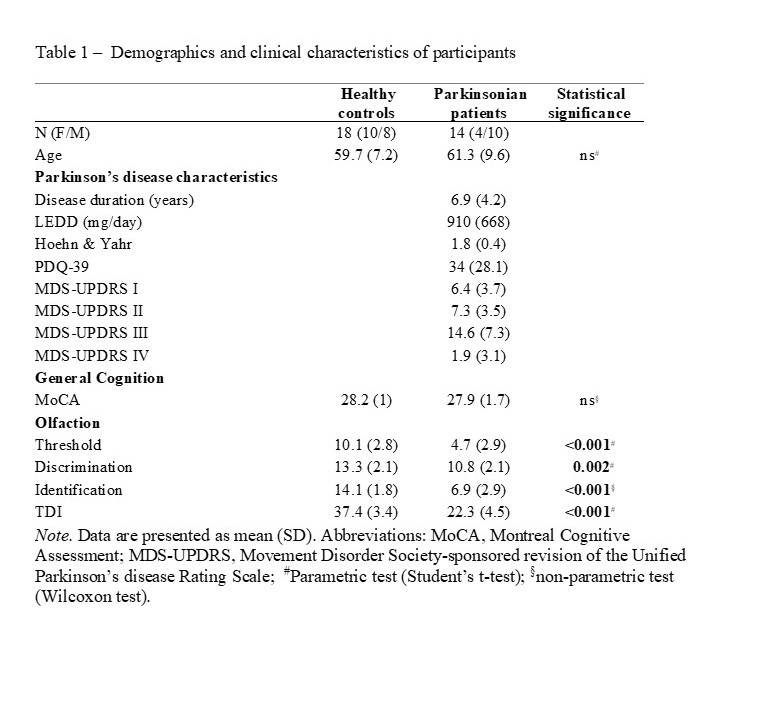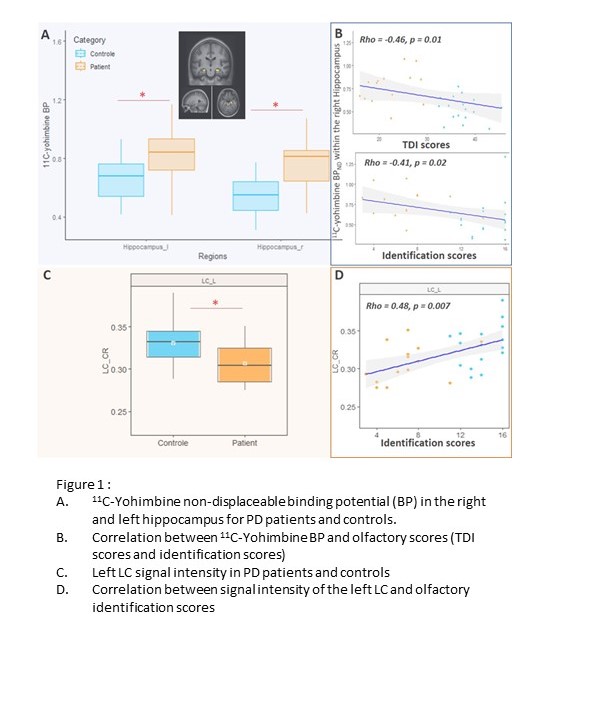Category: Parkinson's Disease: Neuroimaging
Objective: To investigate the relationship between in vivo noradrenergic markers and olfactory impairment in patients with Parkinson’s disease (PD).
Background: Degeneration of the noradrenergic (NA) system is nowadays considered as a pathological hallmark of PD [1]. Olfactory dysfunction is one of the earliest non-motor symptoms of PD but its pathophysiology is still poorly understood [2].
Method: Fourteen PD patients and 18 healthy control subjects were included. Two aspects of the NA system using multimodal in vivo imaging were evaluated: the pigmented cell bodies of the locus coeruleus (LC) with neuromelanin sensitive MRI and the density of α2-adrenergic receptors with PET using 11C-yohimbine. The contrast-to-noise ratio (CNR) was calculated for each LC [3,4]. Independent samples t-tests were used to compare group mean differences in the CNRLC. 11C-yohimbine non-displaceable binding potential (BPND) parametric maps were generated [5] and a regional extraction was carried out on these images for a selection of olfactory brain regions. The 11C-yohimbine BPND values between the two groups were analyzed with a repeated measure analysis of variance controlling for age and gender. Post-hoc analyses were corrected with Bonferroni adjustment for multiple comparisons. We assessed the links between both noradrenergic markers and olfactory characteristics by means of partial correlation coefficients adjusted for age and sex. Significance was set at p < 0.05.
Results: Clinical characteristics of the participants are listed in Table 1. The results of the ANOVA showed an increase in 11C-yohimbine BPND within the hippocampus in PD patients compared to HC [Fig. 1A]. Interestingly, poor olfactory performances were associated with increased 11C-yohimbine BPND in the right hippocampus [Fig. 1B]. In parallel, PD patients showed a reduced signal intensity in the left LC compared with HC (p=0.026) [Fig. 1C], and worse olfactory performances were correlated with a decrease in LC signal intensity [Fig. 1D].
Conclusion: Our results highlight the role of the NA system in the pathophysiology of PD hyposmia. In particular, a decline of LC signal intensity was associated with olfactory identification impairment while an increase in 11C-yohimbine binding within the hippocampus was associated with olfactory impairments in both the detection and identification functions.
Table 1
Figure 1
References: [1] Ray Chaudhuri K, Leta V, Bannister K, Brooks DJ, Svenningsson P. The noradrenergic subtype of Parkinson disease: From animal models to clinical practice. Nat Rev Neurol.2023;19:333-345.
[2] Eek T, Larsson M, Dizdar N. Odor recognition memory in Parkinson’s disease: a systematic review. Frontiers in Aging Neuroscience. 2021 doi: 10.3389/fnagi.2021.625171
[3] García-Lorenzo D, Longo-Dos Santos C, Ewenczyk C, et al. The coeruleus/subcoeruleus complex in rapid eye movement sleep behaviour disorders in Parkinson’s disease. Brain. 2013;136(Pt 7):2120-2129.
[4] Laurencin C, Lancelot S, Brosse S, Mérida I, Redouté J, Greusard E, Lamberet L, Liotier V, Le Bars D, Costes N, Thobois S, Boulinguez P, Ballanger B. (2023) Noradrenergic alterations in Parkinson’s disease: a combined [11C]yohimbine PET/neuromelanin study. Brain. doi: 10.1093/brain/awad338
[5] Laurencin C, Lancelot S, Gobert F, et al. Modeling [11C]yohimbine PET human brain kinetics with test-retest reliability, competition sensitivity studies and search for a suitable reference region. Neuroimage. 2021;240:118328.
To cite this abstract in AMA style:
C. Laurencin, S. Lancelot, S. Brosse, J. Redouté, I. Mérida, D. Le Bars, N. Costes, S. Thobois, P. Boulinguez, B. Ballanger. First in vivo evidence of the role of the noradrenergic system in olfactory dysfunction in Parkinson’s disease [abstract]. Mov Disord. 2024; 39 (suppl 1). https://www.mdsabstracts.org/abstract/first-in-vivo-evidence-of-the-role-of-the-noradrenergic-system-in-olfactory-dysfunction-in-parkinsons-disease/. Accessed December 25, 2025.« Back to 2024 International Congress
MDS Abstracts - https://www.mdsabstracts.org/abstract/first-in-vivo-evidence-of-the-role-of-the-noradrenergic-system-in-olfactory-dysfunction-in-parkinsons-disease/


